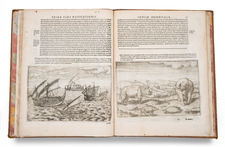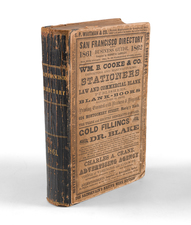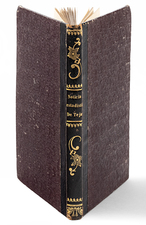True First Issue (Todd Setting "a") of Johnson's Dictionary
"The Most Amazing, Enduring, and Endearing One-Man Feat" - PMM
First edition, true first issue of Dr. Johnson's famous dictionary, with sheets 19D and 24O conforming to William Todd's setting "a" issue points (see below for details).
Johnson's Dictionary of the English Language, published in 1755, stands as a monumental achievement in the history of English lexicography. This ambitious work, compiled single-handedly by Johnson over seven years, was unprecedented in its scale and depth at the time of its publication. Unlike previous dictionaries which were often brief and incomplete, Johnson's dictionary provided over 40,000 entries, each furnished with quotations from literary sources to illustrate usage, showcasing his remarkable command over the language and literary style. His definitions often included witty, insightful remarks that reflected his personal views on the words, making the dictionary not only a practical reference tool but also a compelling read.
The influence of Johnson's dictionary has endured well beyond its immediate impact on the standardization of English spelling and usage. It laid foundational principles for the descriptive treatment of language in lexicography and influenced many subsequent dictionaries, not least the Oxford English Dictionary. Moreover, Johnson's work has permeated literary and educational realms, cementing his reputation as a critical figure in the development of the English language. His dictionary remains a crucial reference for understanding the evolution of English vocabulary and offers a unique window into 18th-century thought and culture.
Dr. Johnson performed with his Dictionary the most amazing, enduring and endearing one-man feat in the field of lexicography... The Preface ranks among Johnson's finest writings... In the field of English lexicography Johnson's greatest followers were American, Webster, and the compilers of the Oxford English Dictionary; but despite the progress made during the past two centuries in historical and comparative philology, Johnson's book may still be consulted for instruction as well as pleasure... Johnson introduced into English lexicography principles which had already been accepted in Europe but were quite novel in mid-eighteenth-century England. He codified the spelling of English words; he gave full and lucid definitions of their meanings (often entertainingly coloured by his High Church and Tory propensities); and he adduced extensive and apt illustrations from a wide range of authoritative writers - PMM
The great American lexicographer, Noah Webster wrote that Johnson's writings had the same effect in philology as Newton's discoveries had in mathematics.
Johnson achieved great nuance in word meaning through his use of thousands of examples from Shakespeare and other great English authors, including Milton, Dryden, Bacon, Newton, Swift, and Pope. Interestingly, Johnson also cites works on practical subjects, such as Mortimer's Husbandry, particularly when a precise technical definition was required.
Nearly every page includes multiple Shakespearan references; here are a few selections:
- Bewitch: Look how I am Bewitch'd; behold mine arm is like a blasted sapling wither'd up - Richard III.
- Bloody: Some bloody passion shakes your very frame - Macbeth.
- Honey: The king hath found, Matter against him, that for ever mars, The honey of his language - Henry VIII.
- Trey: White-handed mistress, one sweet word with thee. Honey, milk, and sugar; there is three. Nay then, two treys; metheglin, wort, and malmsey - Love's Labor Lost.
With Todd's Setting "a" on both 19D and 24O
The present example features setting "a" of both sheets 19D and 24O - thus being a TRUE FIRST ISSUE, as described by William Todd, with the conforming press figures on sheets 19D (found very infrequently per Todd) and on 24O. The identifying press marks on sheet 19D being: 1v: 9 and on 2v: 7; that on 24O (1v): 2. An additional indicator of setting "a" is found in the entry for the word "PART" (sense 7): setting (a) Bacon's Natural History and Milton's Paradise Lost, become in setting (b) Bacon's Nat. Hist. and Milt. Par. Lost.
Todd suggests why the first setting press figures on 19D are so rarely found:
Since the original setting of 19D occurs very infrequently, but 24O quite commonly, it may be conjectured that the resetting of the one came very early after some accident in the printing house, the resetting of the other much later when a shortage was discovered in the sheets.
It is thus very rare to see an example with both 19D and 24O conforming to setting "a" (as in the example in hand); indeed, of the 13 examples examined by Todd only one copy had the "a" setting for both 19D and 24O (See Todd's article in the Book Collector for a full explanation: "...only one of the 13 copies examined represents both early settings."). In addition to examining 13 examples of Johnson's Dictionary Todd also gathered information about Yale's examples through corresponding with Fritz Liebert, director of the Beinecke Library.
Dr. Samuel Johnson, the eminent 18th-century English writer and lexicographer, was born in 1709 in Lichfield, Staffordshire. Renowned for his sharp wit and formidable intellect, Johnson's most enduring and monumental work is A Dictionary of the English Language, published in 1755. This pioneering dictionary was one of the first to comprehensively document the English language and is celebrated for its rich quotations illustrating the usage of words and its clear definitions, setting a standard for later dictionaries. Aside from his lexicographical achievements, Johnson was a prolific essayist, poet, and critic, contributing significantly to English literature through works such as The Lives of the Most Eminent English Poets and Rasselas. His literary circle included figures like James Boswell, who famously profiled him in The Life of Samuel Johnson, chronicling his thoughts and conversations and cementing his status as one of the leading figures of the English Enlightenment.














![(American Revolution - Virginia Privateering) Manuscript Document Concerning the American Privateer Grand Turk, Captured Near Scotland's Fair Isle by Michael Griff [The Capt. of the Privateer Michael Griff declares as follows ...]](https://storage.googleapis.com/raremaps/img/small/82328.jpg)

![(Texas Itineraries for the Mexican Northern Army) Coleccion de Itinerarios Para Diferentes Puntos de la Republica Mexicana, Formados Por la Seccion de Geografia y Estadistica de la Plana Mayor del Ejercito, Mandada Imprimir por Orden del Supremo Gobierno de 14 de Marzo de 1844 [including:] Itinerario Razonado de la Ciudad de S. Luis Potosí al Rio Sabina por el Saltillo](https://storage.googleapis.com/raremaps/img/small/94663.jpg)